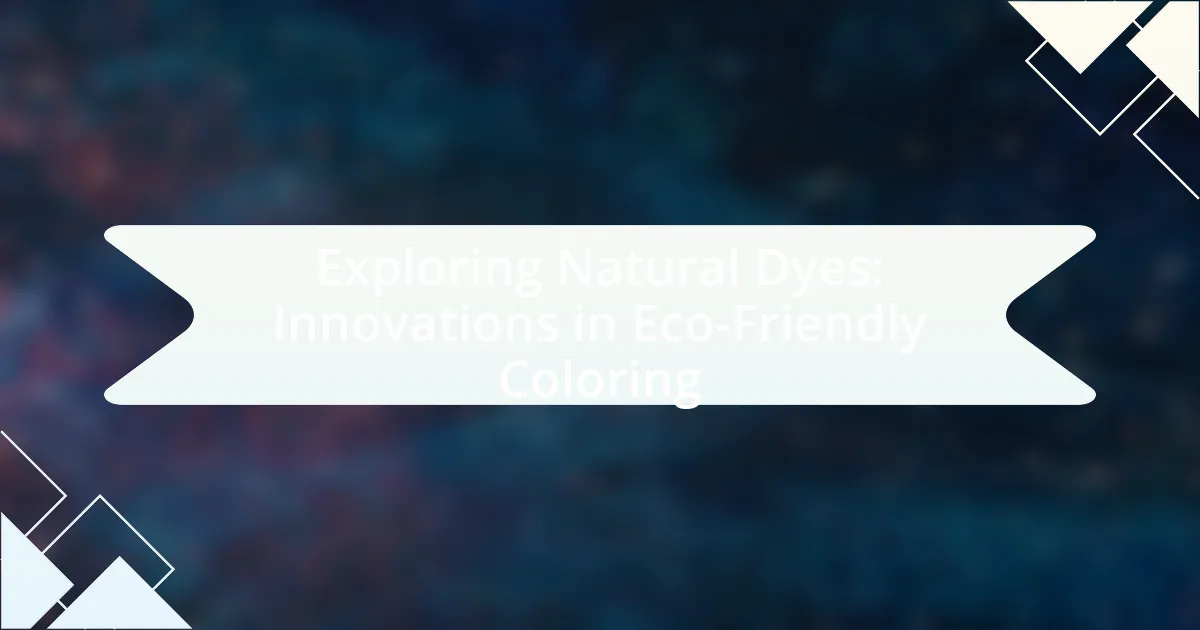Natural dyes, derived from plants, minerals, and insects, offer sustainable alternatives to synthetic dyes, significantly reducing environmental impact due to their biodegradability and lower toxicity. This article explores the differences between natural and synthetic dyes, the historical significance of natural dyes in trade and culture, and the innovations enhancing their use in modern applications. It also addresses the challenges faced by the natural dye industry, including economic factors and competition with synthetic options, while highlighting how consumers can support eco-friendly practices through informed choices. The discussion encompasses advancements in extraction methods and colorfastness, showcasing the growing trend towards sustainability in various industries, particularly textiles and cosmetics.

What are Natural Dyes and Their Importance in Eco-Friendly Coloring?
Natural dyes are colorants derived from natural sources such as plants, minerals, and insects, and they play a crucial role in eco-friendly coloring by providing sustainable alternatives to synthetic dyes. The importance of natural dyes lies in their biodegradability and lower environmental impact, as they do not contain harmful chemicals that can pollute water systems or harm ecosystems. For instance, studies have shown that natural dyes can reduce water pollution by up to 50% compared to synthetic dyes, making them a more environmentally responsible choice for industries like textiles and cosmetics.
How are natural dyes different from synthetic dyes?
Natural dyes are derived from natural sources such as plants, insects, and minerals, while synthetic dyes are chemically manufactured. The primary difference lies in their origin; natural dyes are biodegradable and often less harmful to the environment, whereas synthetic dyes can contain toxic chemicals and may contribute to pollution. For instance, natural indigo is sourced from the indigo plant, whereas synthetic indigo is produced through chemical processes. Additionally, natural dyes typically have a more muted color palette and may require mordants for fixation, while synthetic dyes offer a wider range of vibrant colors and greater colorfastness.
What sources are used to create natural dyes?
Natural dyes are created from a variety of organic sources, including plants, insects, and minerals. Plant sources include roots, leaves, flowers, and fruits, such as indigo from the indigo plant, madder root for red hues, and turmeric for yellow. Insect sources include cochineal, which produces a vibrant red dye, while mineral sources can include ochre for earthy tones. These sources have been historically utilized for their coloring properties, with evidence of plant-based dyes dating back thousands of years in various cultures.
Why is the environmental impact of natural dyes considered lower?
The environmental impact of natural dyes is considered lower because they are derived from renewable resources and typically involve less harmful chemicals in their production. Natural dyes are sourced from plants, minerals, and insects, which reduces reliance on synthetic dyes that often contain toxic substances. For instance, a study published in the Journal of Cleaner Production found that natural dyes can significantly decrease water pollution and energy consumption compared to synthetic alternatives. Additionally, the biodegradability of natural dyes contributes to a reduced ecological footprint, as they break down more easily in the environment without leaving harmful residues.
What historical significance do natural dyes hold?
Natural dyes hold significant historical importance as they were the primary source of color for textiles and art before the advent of synthetic dyes in the 19th century. These dyes, derived from plants, minerals, and insects, played a crucial role in cultural identity, trade, and economic development. For instance, the use of indigo for dyeing textiles dates back over 5,000 years, with evidence found in ancient civilizations such as Egypt and India, where it was highly valued and traded along routes like the Silk Road. Additionally, natural dyes were integral to social status and cultural practices, as specific colors often symbolized rank or were used in ceremonial garments. The historical reliance on natural dyes underscores their significance in shaping human expression and industry throughout history.
How have natural dyes been used in traditional cultures?
Natural dyes have been used in traditional cultures primarily for coloring textiles, crafts, and art. Various plants, minerals, and insects have provided a spectrum of colors, with specific sources tied to cultural significance and local availability. For instance, indigo from the Indigofera plant has been historically utilized in Africa and Asia for its deep blue hue, while cochineal, derived from insects, has been employed in Central and South America to produce vibrant reds. These dyes not only served aesthetic purposes but also held cultural meanings, often symbolizing status, identity, and community ties. The use of natural dyes reflects a deep understanding of local ecosystems and sustainable practices, as communities relied on renewable resources for their coloring needs.
What role did natural dyes play in ancient trade?
Natural dyes were crucial in ancient trade as they significantly influenced the value and desirability of textiles and goods. The vibrant colors derived from plants, minerals, and insects made dyed fabrics highly sought after, leading to extensive trade networks. For instance, the trade of indigo from India and cochineal from Central America became economically important, with these dyes fetching high prices in markets across Europe and Asia. Historical records indicate that the demand for naturally dyed textiles contributed to the establishment of trade routes, such as the Silk Road, facilitating cultural exchange and economic growth.

What Innovations are Emerging in the Field of Natural Dyes?
Innovations in the field of natural dyes include the development of bio-based dyeing processes, advancements in extraction techniques, and the integration of nanotechnology for improved colorfastness. Recent studies have shown that using enzymes and fermentation methods can enhance the extraction of pigments from plants, making the dyeing process more efficient and sustainable. Additionally, researchers are exploring the use of nanomaterials to create dyes that are more vibrant and durable, which addresses the common issue of fading in natural dyes. These innovations not only improve the quality of natural dyes but also promote eco-friendly practices in the textile industry.
How are modern technologies enhancing the use of natural dyes?
Modern technologies are enhancing the use of natural dyes by improving extraction methods, increasing colorfastness, and enabling precise color matching. Advanced techniques such as ultrasonic extraction and supercritical fluid extraction allow for more efficient and higher yield extraction of pigments from natural sources, significantly reducing processing time and resource consumption. Additionally, innovations in dye fixation methods, including the use of mordants that are less harmful to the environment, enhance the durability of natural dyes on various fabrics. Furthermore, digital color matching technologies enable designers to achieve consistent and accurate color results, facilitating the integration of natural dyes into contemporary textile production. These advancements collectively support the growing demand for sustainable and eco-friendly coloring solutions in the fashion and textile industries.
What advancements have been made in dye extraction methods?
Recent advancements in dye extraction methods include the development of eco-friendly techniques such as enzymatic extraction and supercritical fluid extraction. Enzymatic extraction utilizes specific enzymes to break down plant materials, enhancing the yield of natural dyes while minimizing environmental impact. Supercritical fluid extraction employs carbon dioxide under high pressure and temperature to efficiently extract dyes without harmful solvents, resulting in a purer product. These methods have been shown to improve extraction efficiency and reduce waste, aligning with sustainable practices in the textile industry.
How are researchers improving colorfastness in natural dyes?
Researchers are improving colorfastness in natural dyes by developing new mordants and enhancing dyeing techniques. For instance, studies have shown that using metal-based mordants, such as aluminum and iron, can significantly increase the durability of colors on fabrics. Additionally, researchers are exploring the use of natural fixatives, like tannins and plant extracts, which can enhance the binding of dyes to fibers. A notable example is the research conducted by the University of Massachusetts, which demonstrated that combining natural dyes with specific mordants can lead to a color retention increase of up to 50% compared to traditional methods. These advancements not only improve the longevity of natural dyes but also align with eco-friendly practices in textile production.
What are the latest trends in natural dye applications?
The latest trends in natural dye applications include a significant shift towards sustainable practices, increased use of local and indigenous plant materials, and advancements in extraction techniques. Sustainable practices are being prioritized as consumers demand eco-friendly alternatives to synthetic dyes, leading to a rise in small-scale artisans and brands focusing on natural dyeing methods. Additionally, the use of local and indigenous plants not only supports biodiversity but also fosters cultural heritage, as seen in various textile projects worldwide. Advancements in extraction techniques, such as enzyme-assisted extraction, enhance dye yield and color vibrancy, making natural dyes more competitive with synthetic options. These trends reflect a growing awareness of environmental impact and a desire for authenticity in textile production.
How are fashion designers incorporating natural dyes into their collections?
Fashion designers are incorporating natural dyes into their collections by utilizing plant-based materials, minerals, and insects to create sustainable color palettes. This approach not only reduces environmental impact but also promotes biodiversity and traditional dyeing techniques. For instance, brands like Stella McCartney and Eileen Fisher have adopted natural dyes derived from sources such as indigo, madder root, and cochineal, showcasing vibrant colors while minimizing the use of synthetic chemicals. Additionally, the global market for natural dyes is projected to grow significantly, reflecting a rising consumer demand for eco-friendly fashion options.
What industries are adopting natural dyes for sustainability?
The textile industry is primarily adopting natural dyes for sustainability, driven by consumer demand for eco-friendly products. This shift is evident as brands increasingly seek to reduce their environmental impact, with natural dyes offering biodegradable and non-toxic alternatives to synthetic dyes. Additionally, the cosmetics industry is also embracing natural dyes, utilizing plant-based pigments for safer and more sustainable beauty products. The food industry is incorporating natural dyes to enhance product appeal while adhering to health regulations, as these dyes are often derived from fruits, vegetables, and spices. This trend reflects a broader movement towards sustainability across multiple sectors, emphasizing the importance of environmentally responsible practices.
What Challenges Do Natural Dyes Face in Today’s Market?
Natural dyes face significant challenges in today’s market, primarily due to competition from synthetic dyes, which are often cheaper and more consistent in color. The demand for natural dyes is hindered by their limited color range, variability in dyeing results, and the labor-intensive processes required for extraction and application. Additionally, the scalability of production remains an issue, as sourcing raw materials can be inconsistent and dependent on agricultural conditions. According to a study published in the Journal of Cleaner Production, the market share of natural dyes is only about 5% of the total dye market, highlighting the dominance of synthetic alternatives.
What are the limitations of using natural dyes compared to synthetic options?
Natural dyes have several limitations compared to synthetic options, primarily in terms of color consistency, lightfastness, and availability. Natural dyes often produce less vibrant and varied colors, as they are dependent on the source materials, which can lead to inconsistencies in hue and saturation. Additionally, natural dyes typically have lower lightfastness, meaning they fade more quickly when exposed to sunlight compared to synthetic dyes, which are engineered for durability. Furthermore, the sourcing of natural dyes can be limited by seasonal availability and geographic factors, making them less reliable for large-scale production. These limitations highlight the challenges of using natural dyes in commercial applications where consistency and durability are critical.
How does the availability of raw materials affect natural dye production?
The availability of raw materials directly influences natural dye production by determining the types and quantities of dyes that can be sourced. When raw materials, such as plants, minerals, or insects, are abundant, producers can create a wider variety of colors and achieve consistent quality in their dye products. Conversely, limited access to these materials can restrict production capabilities, leading to a reliance on fewer dye sources and potentially higher costs. For instance, the decline in certain plant species due to environmental changes can result in reduced availability of specific dyes, impacting both the diversity and sustainability of natural dye production.
What are the economic challenges faced by producers of natural dyes?
Producers of natural dyes face several economic challenges, primarily including high production costs and limited market demand. The cultivation of plants for dye extraction often requires significant investment in land, labor, and resources, which can lead to higher prices compared to synthetic dyes. Additionally, the market for natural dyes is relatively niche, resulting in lower sales volumes and limited economies of scale. According to a study published in the Journal of Cleaner Production, the cost of raw materials for natural dyes can be up to 30% higher than those for synthetic alternatives, further complicating profitability for producers.
How can consumers support the natural dye industry?
Consumers can support the natural dye industry by choosing products dyed with natural substances instead of synthetic dyes. This choice encourages manufacturers to source and produce more items using eco-friendly dyes, which can lead to a sustainable market. According to a report by the Textile Exchange, the demand for organic and natural textiles has been steadily increasing, indicating a growing consumer preference for environmentally responsible options. By purchasing from brands that prioritize natural dyes, consumers directly contribute to the viability and expansion of this industry.
What practices can individuals adopt to promote eco-friendly coloring?
Individuals can promote eco-friendly coloring by using natural dyes derived from plants, fruits, and vegetables instead of synthetic dyes. Natural dyes are biodegradable and reduce environmental pollution, as they are made from renewable resources. For instance, turmeric can produce a vibrant yellow, while beetroot yields a rich red hue. Additionally, individuals can opt for organic materials and sustainable practices, such as sourcing local ingredients and minimizing water usage during the dyeing process. This approach not only supports local agriculture but also decreases the carbon footprint associated with transporting synthetic dyes. By adopting these practices, individuals contribute to a more sustainable and environmentally friendly coloring process.
How can consumers identify and choose products made with natural dyes?
Consumers can identify and choose products made with natural dyes by looking for specific labels and certifications that indicate the use of such dyes. Products labeled as “organic,” “eco-friendly,” or “made with natural dyes” often meet these criteria. Additionally, consumers can research brands that prioritize sustainability and transparency in their manufacturing processes, as many reputable companies provide information about their dye sources on their websites. For instance, the Global Organic Textile Standard (GOTS) certification ensures that textiles are made with organic fibers and natural dyes, providing a reliable benchmark for consumers.
What are some practical tips for using natural dyes at home?
To effectively use natural dyes at home, start by selecting appropriate plant materials such as onion skins, beetroot, or turmeric, which are known for their strong pigmentation. Prepare the dye by boiling the plant materials in water for at least an hour to extract the color. Strain the mixture to remove solid particles, leaving a concentrated dye solution. Pre-treat fabrics with a mordant like alum or vinegar to enhance color absorption; this step is crucial as it helps the dye bond with the fabric fibers. Finally, immerse the pre-treated fabric in the dye solution for a duration that varies based on the desired intensity, typically ranging from 30 minutes to several hours. This method is supported by historical practices where natural dyes have been used for centuries, demonstrating their effectiveness and sustainability in textile coloring.

Leave a Reply